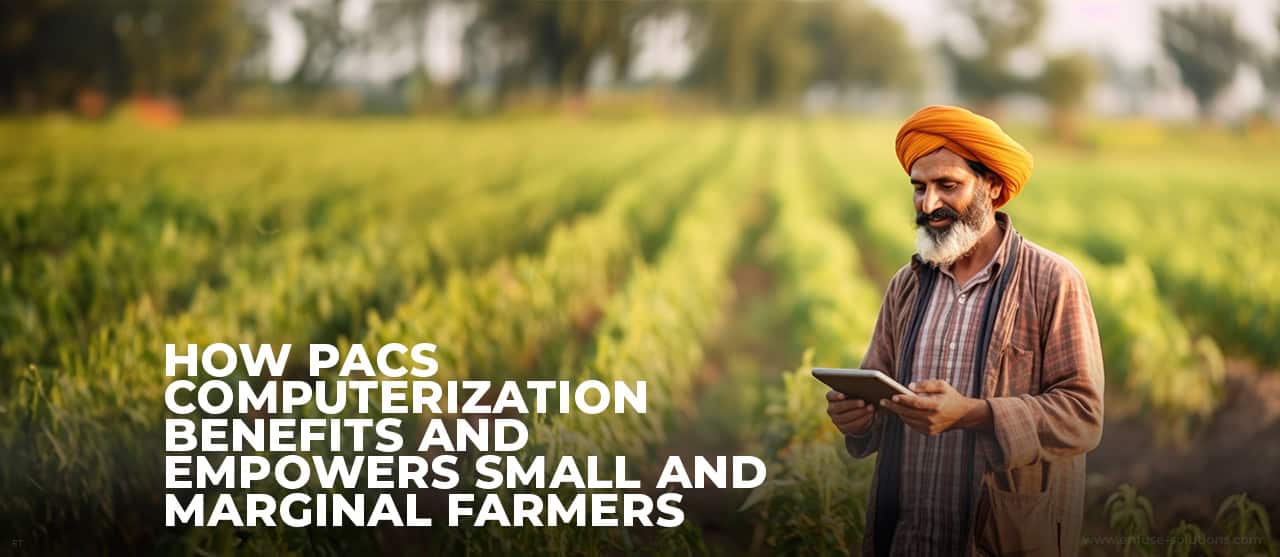
Across the globe, farming serves as a crucial means of sustenance for countless individuals. In countries such as India, the farming sector is largely comprised of small-scale and marginalized farmers. Nevertheless, these individuals are frequently met with barriers when attempting to obtain resources, market knowledge, and support from governmental initiatives.
Over the past several years, a determined initiative has emerged to strengthen these farmers by computerizing Primary Agriculture Cooperative Societies (PACS). This metamorphosis has not only enhanced the effectiveness of operations for these societies but also yielded an array of advantages for small and underserved farmers.
In this blog, we shall delve into how PACS computerization is enabling the empowerment of farmers and revolutionizing the agricultural terrain for the positive.
What Are PACS?
Primary Agricultural Credit Societies, known as PACS, are very important for supporting the agricultural credit system in India. They were set up to provide financial help that is easily available and not at all expensive for marginalized and small-scale farmers across the country. These groups work on a local level, giving monetary aid straight to the farmers who are part of their community.
PACS, established at the village or mandal level and incorporated under the State Co-operative Societies Act, comprises predominantly small-scale and economically disadvantaged farmers, including female members and landless laborers. These societies strive to provide expeditious and ample financing to farmers for their agricultural and non-agricultural needs. This includes loans for crop production, farm input purchases, livestock, and rural infrastructure development.
What Is PACS Computerization?
The Government of India, acknowledging the necessity for modernization and overcoming a previous lack of technological progress in operation by Primary Agricultural Credit Societies (PACS), sanctioned on June 29, 2022, an ambitious initiative: The Centrally Sponsored Project for Computerisation.
This program is set to run ambitiously over five years—from 2022-23 to 2026-27—with robust financial backing, its significance is underlined through a substantial allocation amounting to ₹2,516 crore. Striving to digitalize 63,000 operational PACS, the project aims to integrate them into a centralized national software that operates on Enterprise Resource Planning (ERP).
The plan also includes merging these PACS with the National Bank for Agriculture and Rural Development (NABARD) through State Cooperative Banks and District Central Cooperative Banks; this endeavor represents a significant milestone in equipping agricultural credit societies with cutting-edge technological resources, which is an initiative designed not only to enhance financial accessibility but also boost overall efficiency within the agricultural sector.
What Are The Objectives Of PACS Computerization?
- Improving the overall operational effectiveness of PACS to streamline their processes and functions.
- Speeding up the loan distribution, reducing costs of transactions, and lessening differences in how payments are handled to make financial activities more efficient.
- Combining accounting methods smoothly with District Central Cooperative Banks (DCCBs) and State Cooperative Banks (StCBs) to improve clarity in money dealings.
- Cultivating trust among farmers by improving the reliability and credibility of PACS operations.
- Introducing a single Common Accounting System (CAS) and Management Information System (MIS) to give online tools for PACS, so they can get refinance and loans from the National Bank for Agriculture and Rural Development (NABARD) using DCCBs and StCBs. These funds are meant for various farming activities.
What Are The Benefits Of PACS Computerization?
1. Enhanced Access To Credit Facilities
Previously, obtaining loans from PACS entailed a tedious process that required extensive paperwork and manual steps. However, with the emergence of computerization, this process has been transformed, enabling farmers to easily apply for loans through online platforms. Consequently, loan disbursement has become swifter, mitigating opportunities for corruption and malpractices.
2. Transparency In Loan Processes
In addition, the digitalization of PACS promotes transparency in its operations. No longer do farmers have to rely solely on word-of-mouth to determine loan eligibility and interest rates. This outdated approach often left them susceptible to exploitation by middlemen. Thanks to the implementation of computerization, essential loan details are now readily available online, promoting transparency and preventing exploitation.
3. Digitization Of Land Records
In India, land records play an integral role in obtaining financial aid for farmers. However, pervasive problems such as deceitful land transactions and inaccuracies in records hindered the farmers’ ability to secure loans. PACS computerization digitizes land records, making them tamper-proof and convenient to obtain. This streamlines the loan approval process, enabling farmers to swiftly secure credit.
4. Empowering Farmers Through Information Access
Through online portals and mobile applications, farmers are equipped with extensive insights on crop patterns, weather predictions, government initiatives, market costs, and beyond. This valuable knowledge empowers farmers to make enlightened choices about their crops, while also remaining current on cutting-edge farming techniques and technologies.
Conclusion
The computerization of PACS signifies a paramount transition towards modernizing agricultural methodologies and granting authority to farmers throughout India. Beyond mere digitization, this endeavor holds the potential to ignite socio-economic progress at the grassroots level.
By utilizing technology to streamline operations, enhance transparency, and promote financial inclusivity, PACS computerization not only simplifies access to credit but also unveils a plethora of possibilities for rural communities. Fostering trust and building credibility in the agricultural credit system forms the bedrock for enduring growth and resilience amidst changing obstacles.
As we observe this revolutionary journey, it emphasizes the significant influence that strategic investments in technology can bring to bettering the lives of those who labor on the soil, solidifying agriculture’s role as a pillar of advancement and prosperity for our country.
To unlock the full potential of the digital revolution in agriculture, envision EnFuse as your trusted navigator through the challenges ahead. Take the first step by reaching out to us.

















Comment